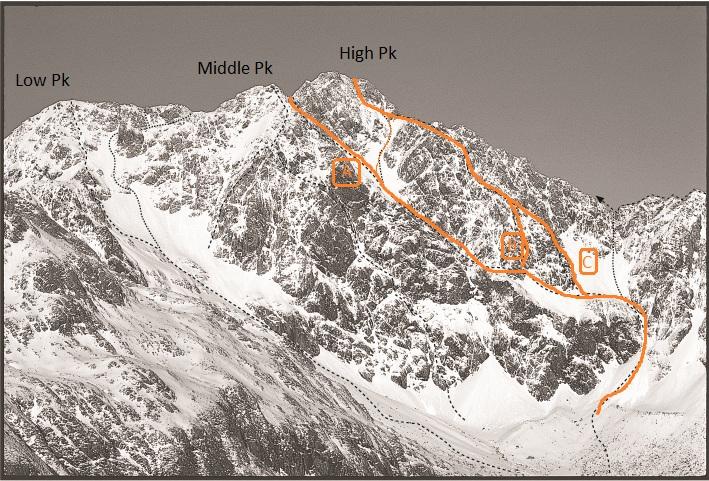For experienced parties, a diversity of routes may be taken up the 900m Otira Face of Mt Rolleston. Some of the routes are very difficult, and more often than not, the rock can be quite rotten in zones as determined by the obvious synclined strata!
Routes on the Otira Face of the Middle Peak are listed separately.
Routes
| Reference | Title | Grade | Length | Pro | Quality | Alert | Operations |
|---|---|---|---|---|---|---|---|
| A | AOtira Couloir, 2 | 2 | 0m | ||||
This route leads up the dangerous central gut between High and Middle Peaks. It is prone to continuous avalanche activity in winter, and rockfall in summer. Climbers generally choose to join the Philistine Ridge near the upper snow basin. |
|||||||
| B | BLeft Flank, 2 | 2 | 0m | ||||
From the snow/scree Field at the base of the Central Direct route keep moving left until the nose of a rocky arete is reached. Climb on generally exposed rock, with poor protection, to join the Philistine Ridge. |
|||||||
| C | CCentral Direct, 2 | 2 | 0m | ||||
This route, on the right-hand side of the central gut is by far the most popular (not only because it tops out on High Peak). Most of the climb takes place on the prominent buttress that appears to lead directly to High Peak. The buttress is reached by climbing from the Otira Valley onto the permanent snow-field at its base, via either the loose green bluffs and ramps (adjacent the central gully), or better still the narrow couloir that joins the Philistine-Rolleston Ridge (a route in its own right). Routes on the buttress are many and varied. The rock is surprisingly solid, and the ensuing 500 metres is a climb to be relished. In contrast the next 200 metres is upon the stacked blocks and broken buttresses of the Philistine-Rolleston Ridge. The final 50 metres is good solid rock and is easily climbed to High Peak. |
|||||||
| Westweg, 15 | 15 | 150m | |||||
The Central Direct ridge can be gained on its West side by a 150m long banana shaped corner rising above the snow field. The final 60 meters offers the best climbing on either face of the corner, offering either good rock and poor protection or loose rock and good protection. |
|||||||
| Crocodile Rock, 15 | 15 | 300m | |||||
|
A pair of diamond-shaped faces to the climber's right of Central Direct - in between Westweg and Headstone Gully. Excellent rock, and not just by AP standards! Approach as for Central Direct, but head climbers' right past the base of the buttress and scramble to the base of the faces. Hoover up the crack in the centre of the diamond-shaped face at grade ~15-16. Soloed on ascent but looked like it would eat up gear - small nuts, cams 0.5-1, potentially 2-3 in a short section of crack but here the angle has eased off. Continue up and over the top of the diamond and traverse left into the second face. This unfortunately misses the bottom of the second face, however to be fair it looks thin and difficult to protect. Continue up on more cracks (~14-15) until you meet and continue up the Philly-Rolly ridge to summit.
|
|||||||
| Headstone Gully, 2+ | 2+ | 250m | |||||
The route follows the gully to the right of the access for Central Direct (Mt Rolleston -Otira Face). Climb to the top of the scree slope at the base of the climb and join the gully from there. The climbing on the lower half of the route is on reasonably solid rock and is relatively straightforward. The rock gets looser as you approach the prominent overhang/ roof at about 2/3 height, there is possibilities for good anchor on right hand side of overhang (small cams helpful e.g. .5 camalot and smaller). Climb around overhang via weakness on wall at right side (crux), this section is tricky but is protectable and leads to easier ground. A couple of short scree tiers lead to the final gully system. Climb these gullies to the ridge top. The top gullies are insecure and offer limited chance for protection. Climb to summit via Philistine-Rolleston Ridge |
|||||||

